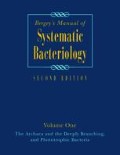Abstract
Microbiology has entered the molecular age. Almost every month another complete bacterial genome sequence is published (e.g., Fleischmann et al., 1995; Cole et al., 1998), and it is now routine to start the classification of a newly isolated microorganism with the determination and comparative analysis of at least one nucleic acid sequence. Clearly, the most commonly used molecule for this purpose is the ribonucleic acid of the small subunit of the ribosome, the 16S rRNA of Bacteria and Archaea. The high information content of nucleic acid sequences can, in principle, be accessed by two techniques. One is sequencing followed by comparative sequence analysis; the second is hybridization with nucleic acid probes.
Preview
Unable to display preview. Download preview PDF.
Editor information
Editors and Affiliations
Rights and permissions
Copyright information
© 2001 Springer Science+Business Media New York
About this chapter
Cite this chapter
Amann, R., Schleifer, KH. (2001). Nucleic Acid Probes and Their Application in Environmental Microbiology. In: Boone, D.R., Castenholz, R.W., Garrity, G.M. (eds) Bergey’s Manual® of Systematic Bacteriology. Springer, New York, NY. https://doi.org/10.1007/978-0-387-21609-6_9
Download citation
DOI: https://doi.org/10.1007/978-0-387-21609-6_9
Publisher Name: Springer, New York, NY
Print ISBN: 978-1-4419-3159-7
Online ISBN: 978-0-387-21609-6
eBook Packages: Springer Book Archive

